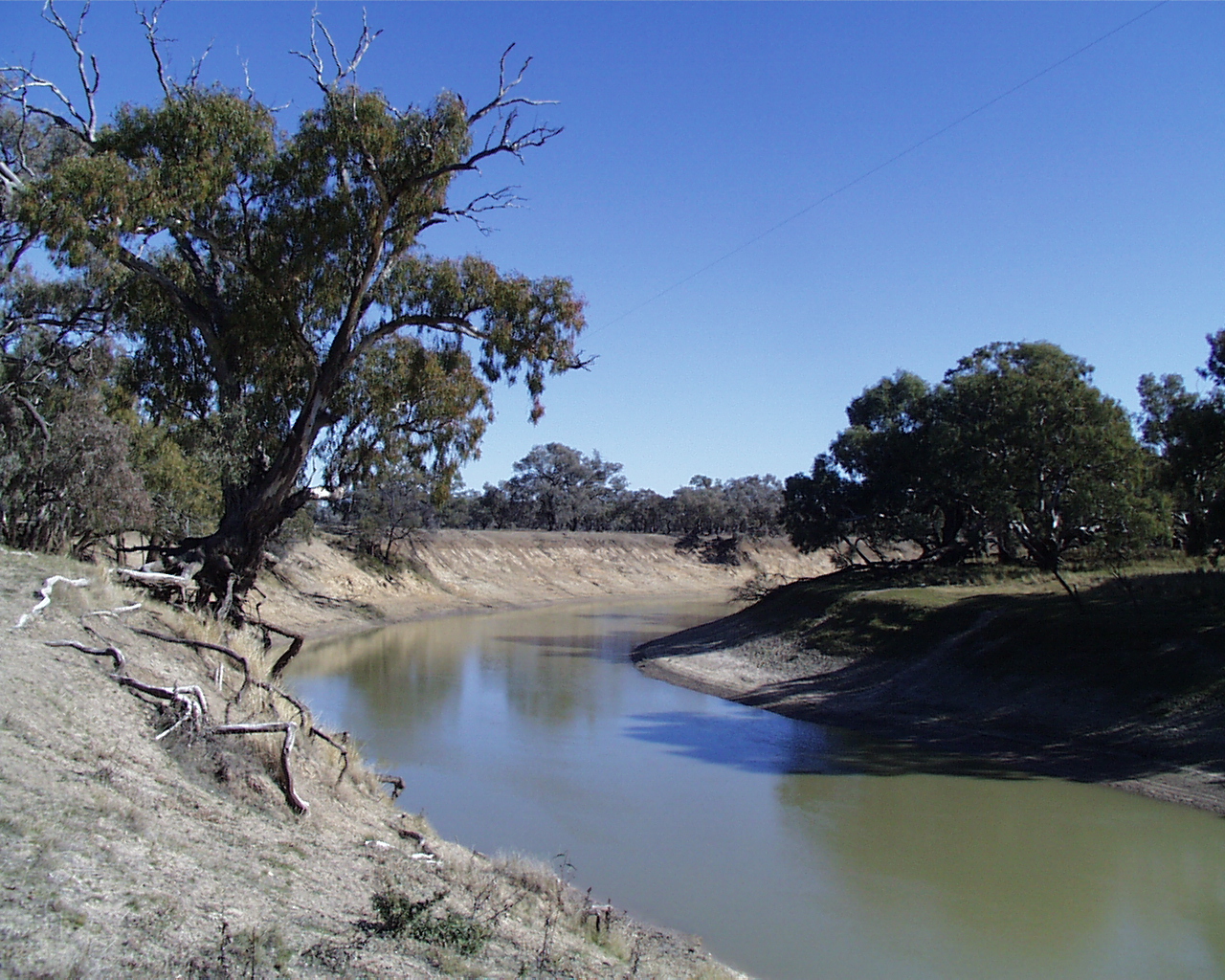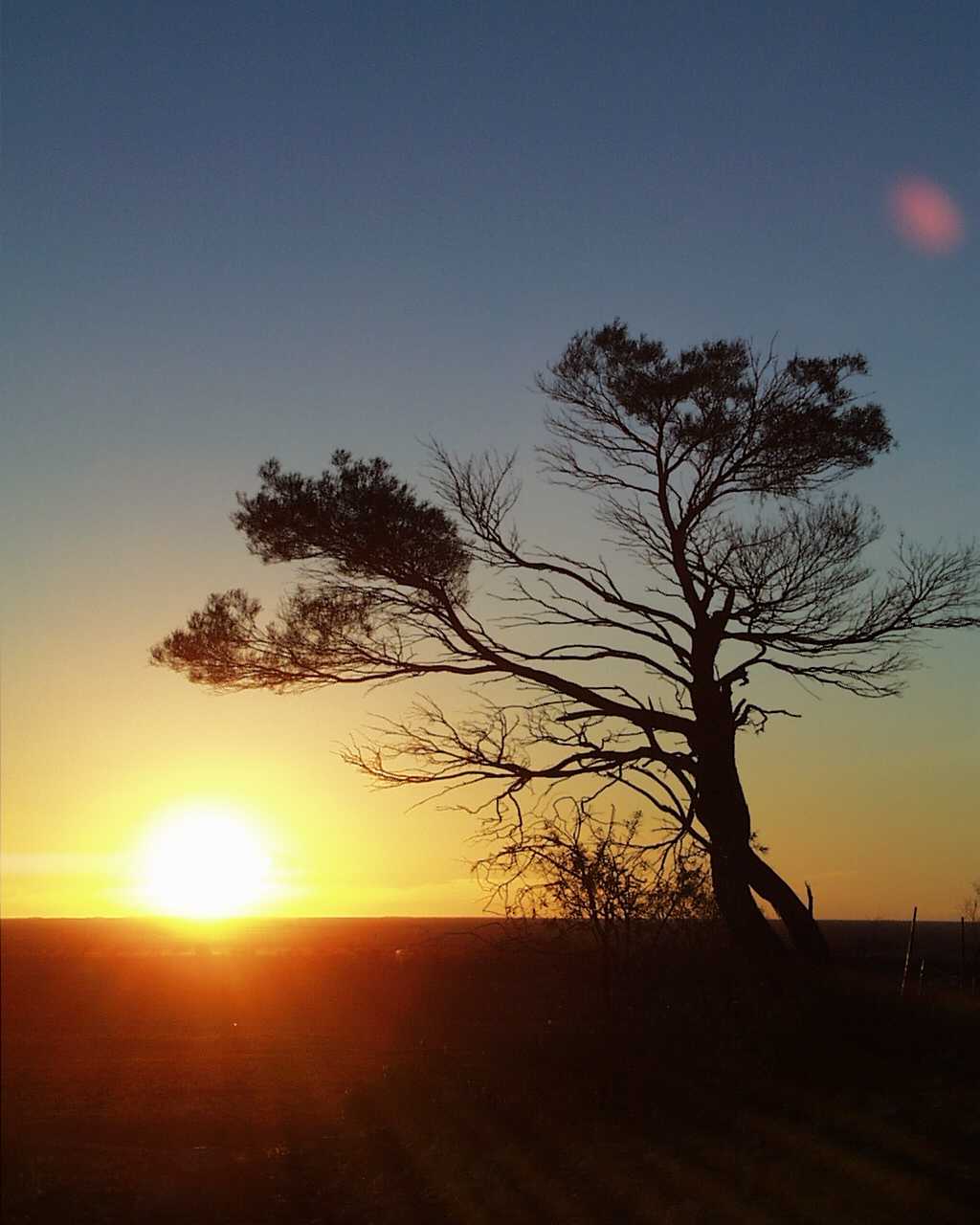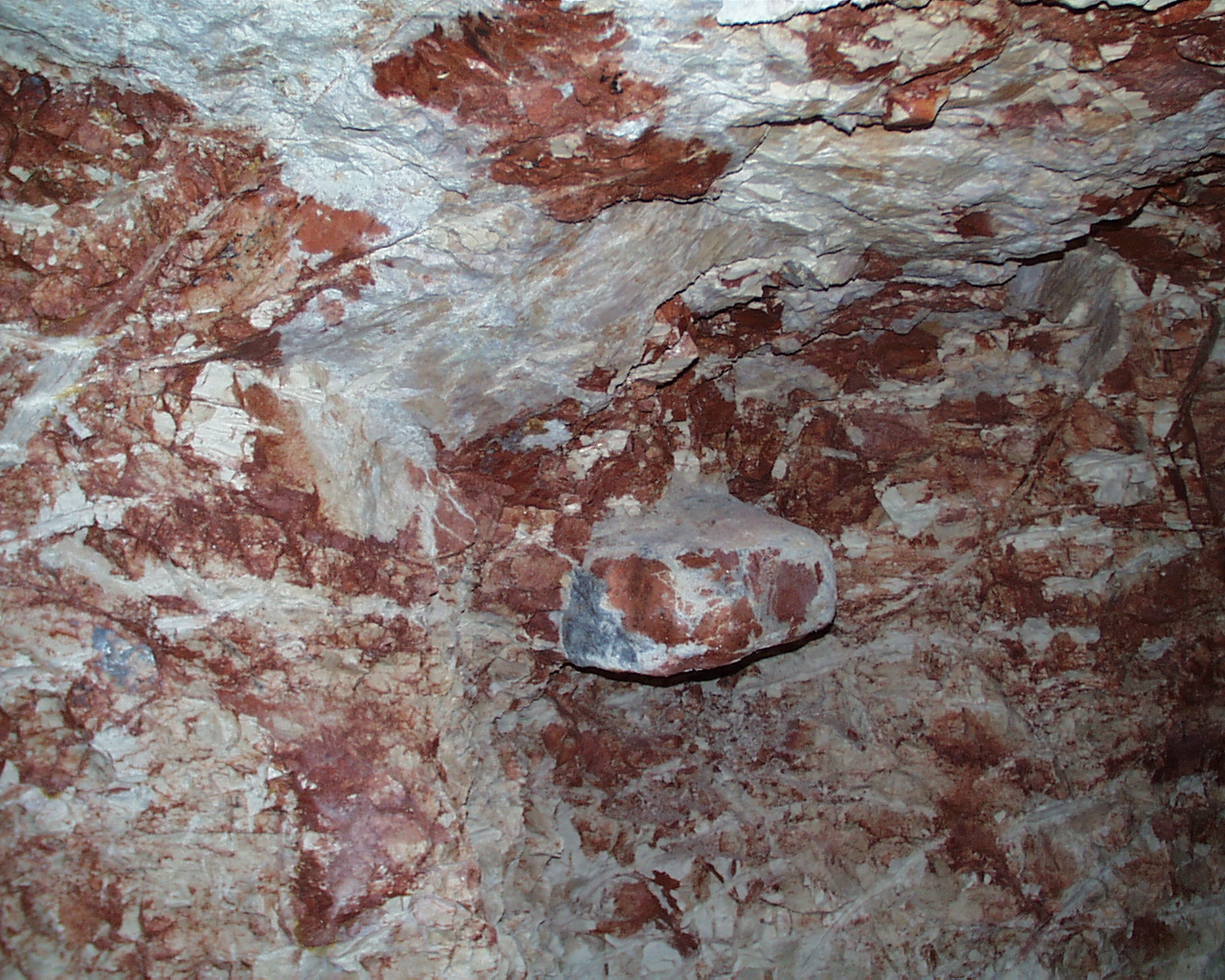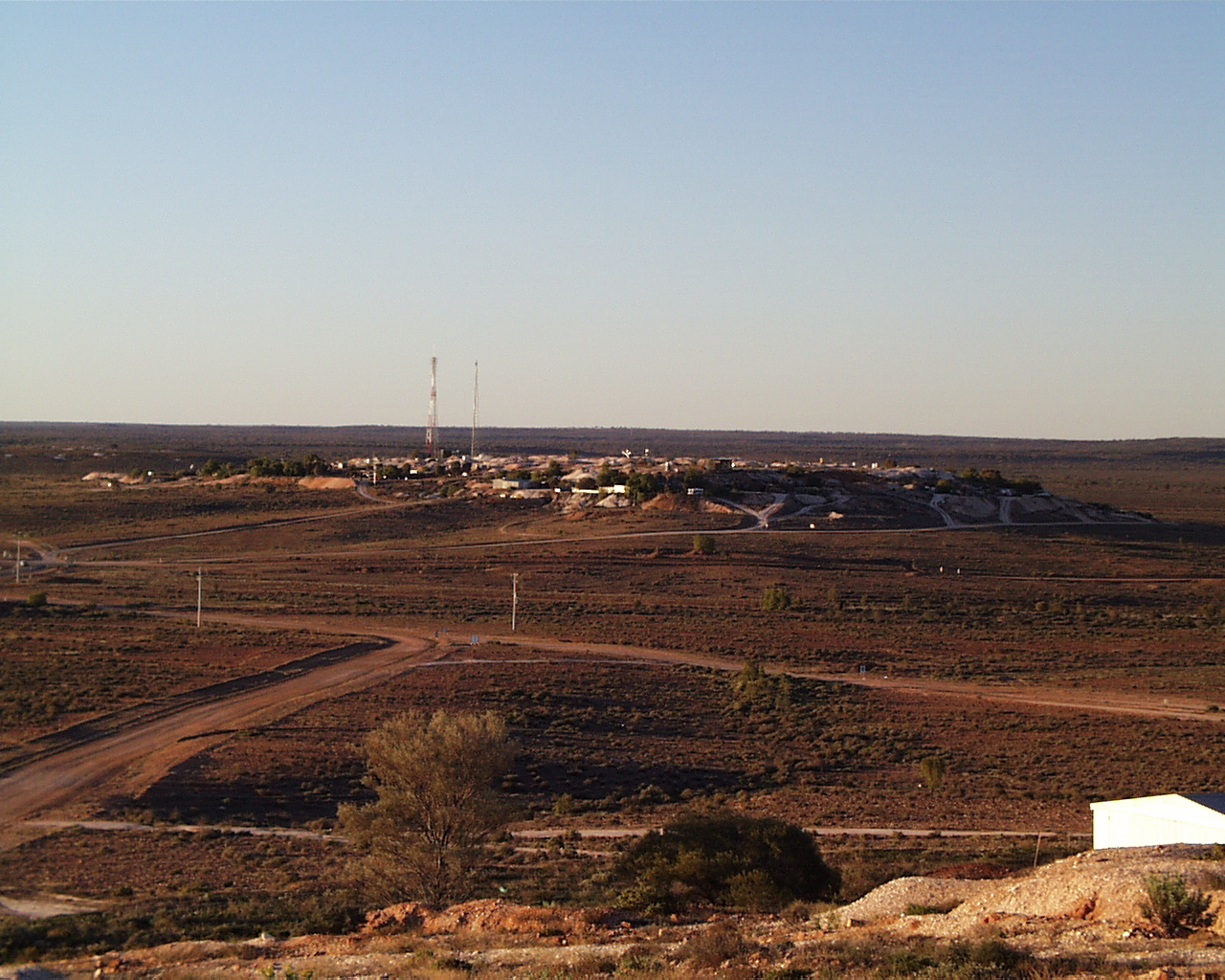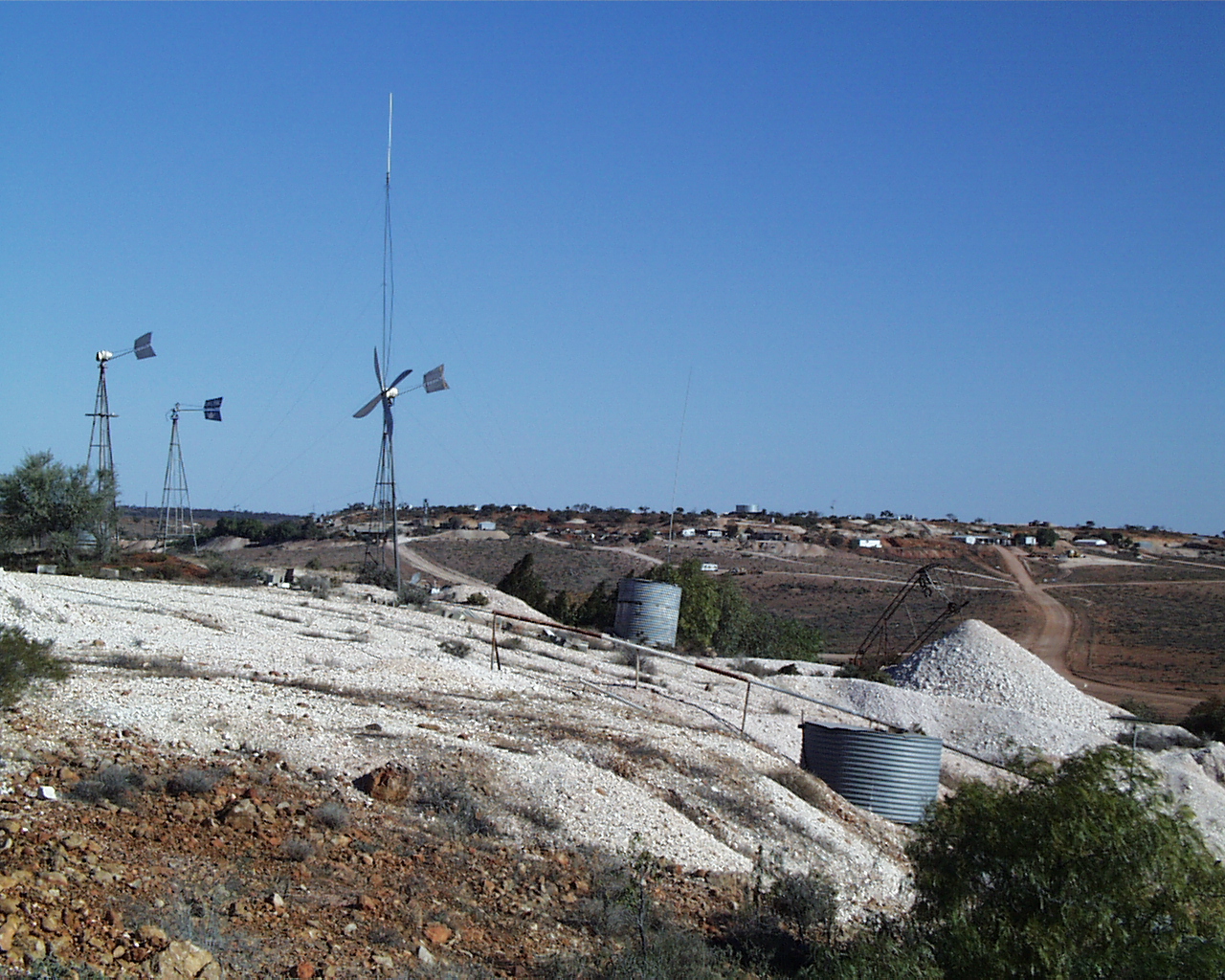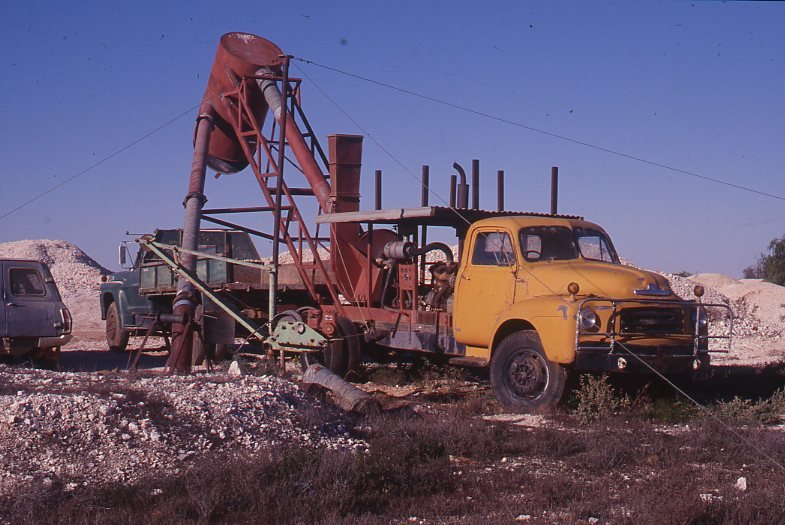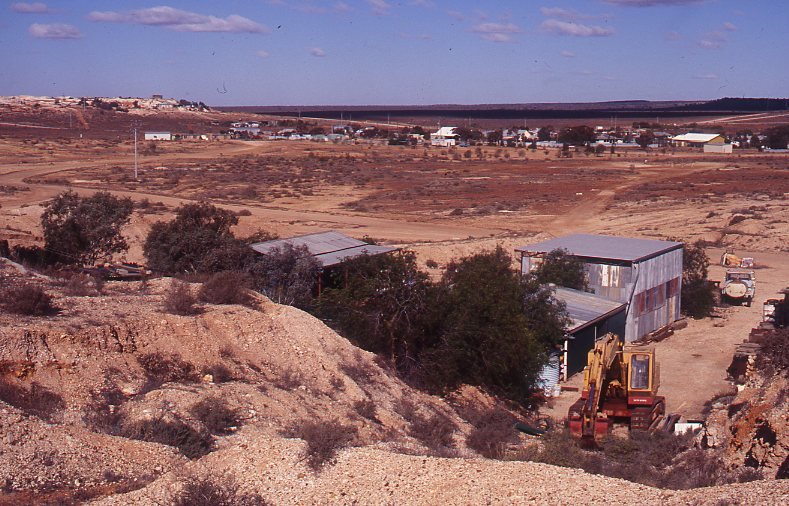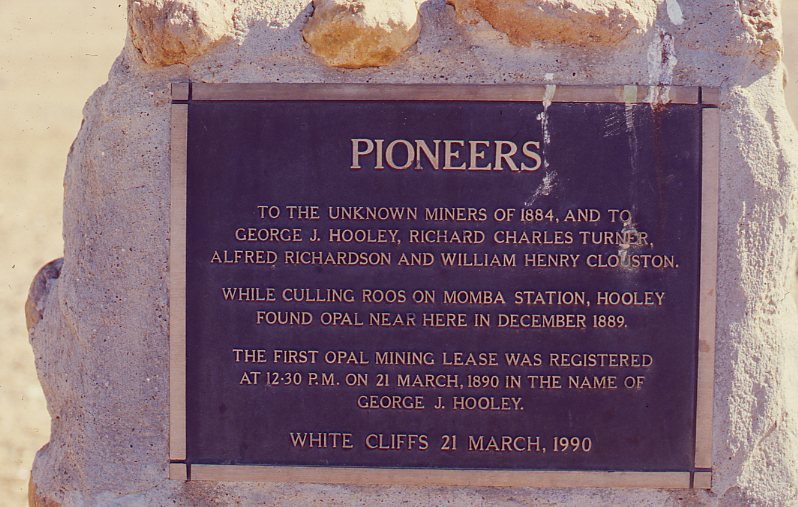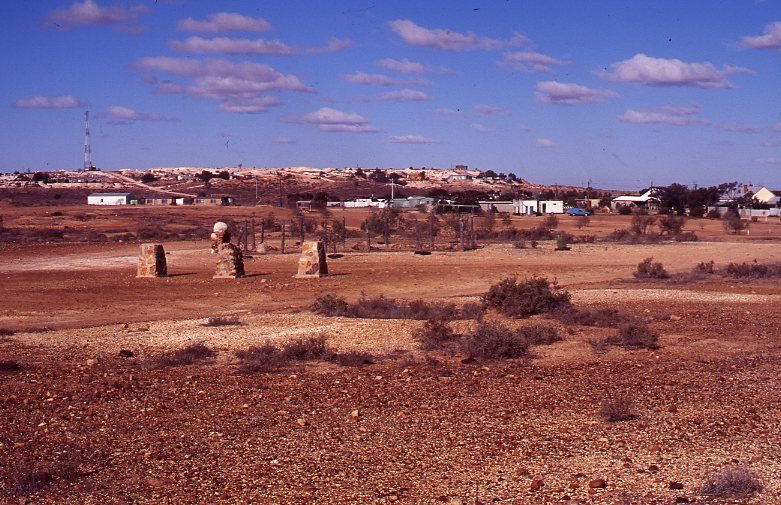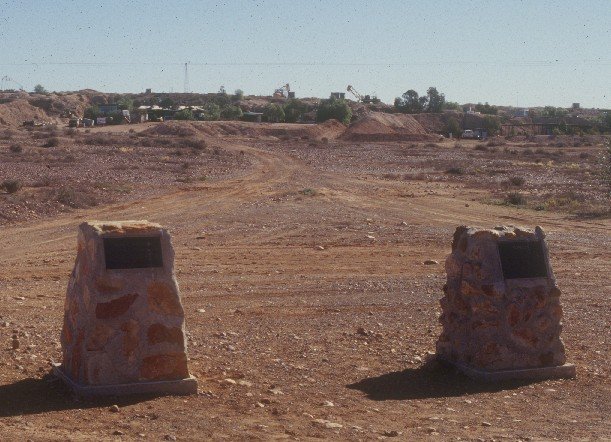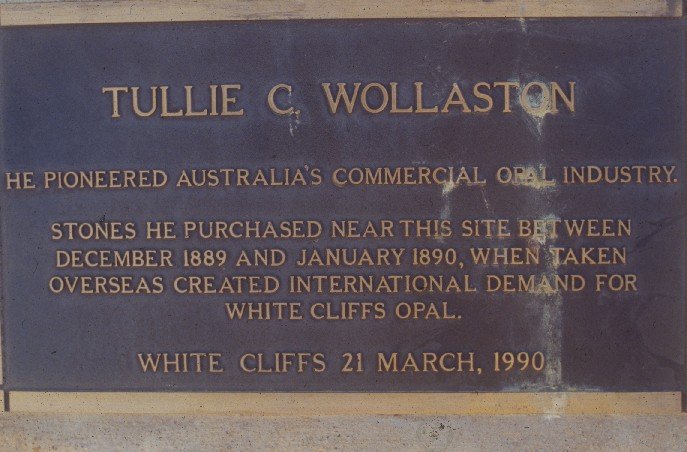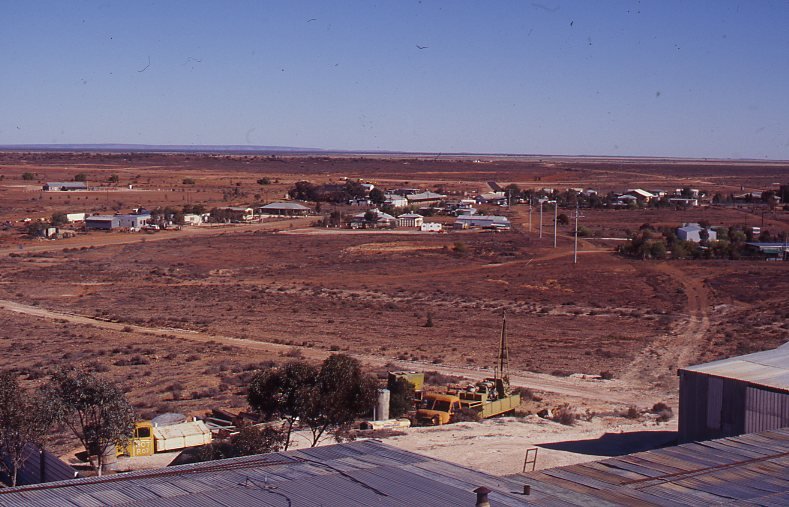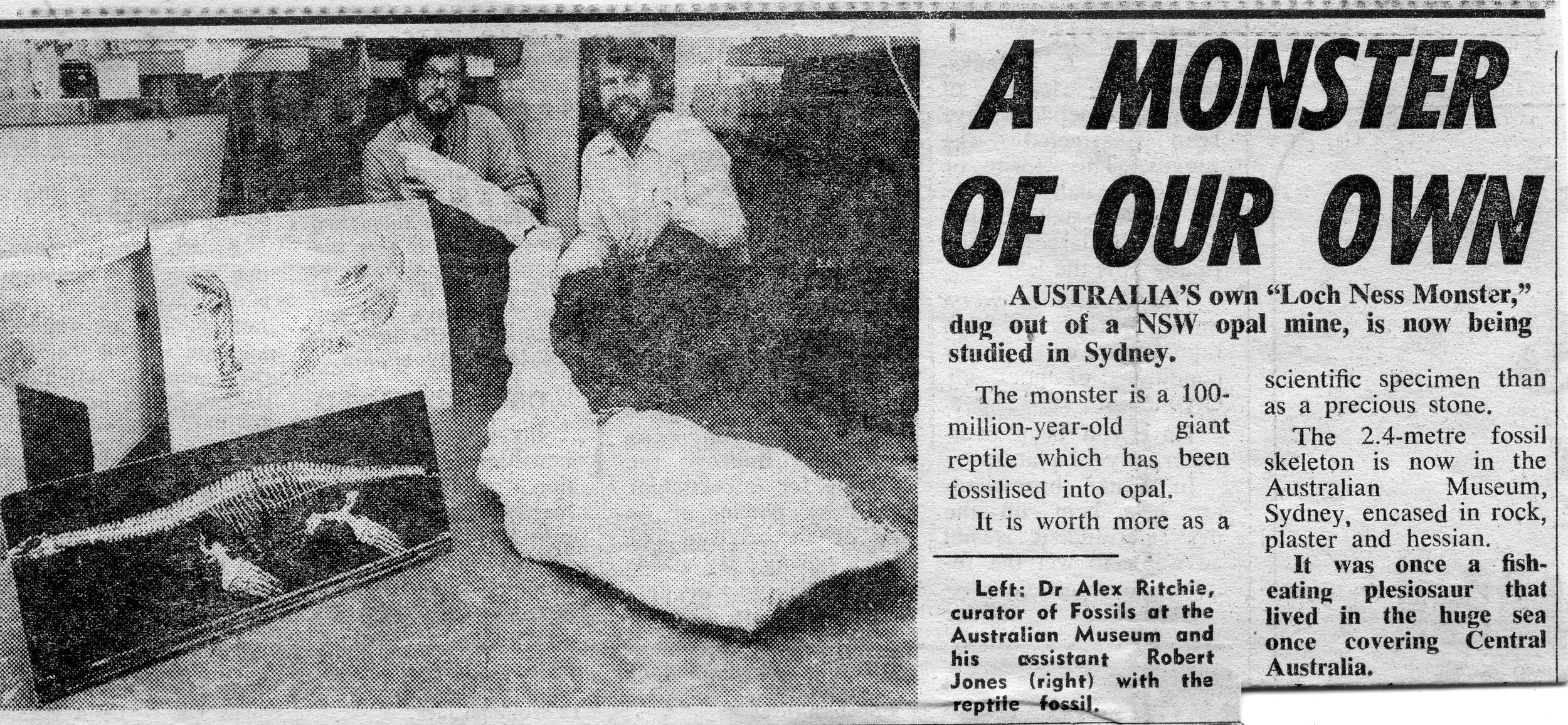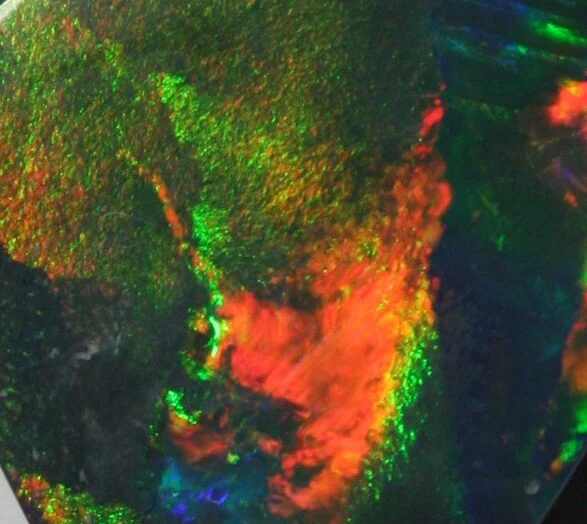White Cliffs Opal Fields
a little history
White Cliffs Opal field and township is located approximately 95 kilometres North North West of the township of Wilcannia in NSW. Wilcannia is located on the Darling River and Barrier Highway some 192 kilometres east of Broken Hill or 980 kilometres west of Sydney in Parish of Kirk, County of Yungnulgra.
The Opal is recorded as being discovered first of all in 1881 by Warden WHJ Slee near Milparinka. However this early history is perhaps a mystery. Len Cram in his “Journey with Colour Volume 2A” discusses the details. It would seem that the history of opal occurrences in the area is quite convoluted.
However perhaps the initial and more commercial mining information records the opal story with reference to four men who were kangaroo shooters on Momba station. So the discovery and first mining at White Cliffs is attributed to Messrs: George Hooley, Alf Richardson, Richard Turner and William Clouston. et al. in 1889 on the Momba Pastoral Company’s Station.
Editor: Here is an interesting part of the opal mining history in White Cliffs. There is a question I always ask my students when lecturing opal history. It is something that links precious opal in Australia to our Australian history as a whole.
My question is …when did Federation occur in Australia? The answer of course is 1901.
So here is the association with opal. One of the first three “Royal Commissions” enacted by the State of NSW under the new federation and was an investigation into Opal Mining in White Cliffs!
An early map, Circa 1894 of the White Cliffs opal fields, on the Momba pastoral Holding, Parish of Kirk, County of Yungnulgra, Albert Mining District, Wilcannia district, Western Division NSW.
the cover of Len Cram’s “A journey with Colour” the most up-to-date history of the White Cliffs opal fields.
the cover of a text by Gwen Rowe, White Cliffs Historical Society detailing the early history of opal mining in White Cliffs.
White Cliffs Town c1906 Photo: Sherman Archives, postcard from Centenary celebrations 1990, White Cliffs Historical Society.
The Opal King Hotel, White Cliffs, c1901, Sherman Archives, postcard from Centenary celebrations 1990, White Cliffs Historical Society
You can read a little more interesting history from some old magazine and newspaper clippings here:
early opal trading
Looking then at the discovery of precious noble opal in the district of White Cliffs, in let us say 1890 when it is recorded the first mining lease was registered by George Hooley. We need to take into consideration that perhaps White Cliffs opal field was the very beginning of more substantial, commercial trading, or the substantiation of trading in the opal industry in Australia. There is no doubt that the industry began with the discovery of opal near Quilpie in central Queensland as Len Cram recalls in Chapter four, Volume 2A of A Journey with Colour, and the attempt of Herbert Bond who is accredited with floating an opal mining company with an attempt to sell Australian Precious opal in London. This is also recorded in Len Crams “Journey with Colour” in the Queensland boulder opal fields, Ed. This will be available in our blog on the Queensland fields. (we are yet to share a blog on the Queensland fields…it is coming!)
Sometimes history can be a little convoluted, so there is a discussion to be made as to where the Australian opal industry began on a commercial basis. Records show that the first opal lease for opal was in 1890 in White Cliffs, NSW. Made by George Hooley. The first discoveries of precious noble opal that were “commercialised” came from the Queensland boulder opal fields. The “father” of the Australian opal industry, Tullie Cornwaith Wollaston was the first person to commercially market Australian Precious opal. His story is recorded in his dairy “Opal Gem of the Never Never” and whilst this is mostly a description of his early trips to the opal fields in Queensland, (Editor, Please refer to the post on Boulder opal in Queensland it is worthy of discussion Wollaston’s involvement with precious noble opal in White Cliffs.
Wollaston records in the aforementioned book:
“between 1891, then , and 1901, White cliffs was in full swing, and, with about 700 miners working, it hummed louder perhaps than any other spot of equal area in australi, not even excepting Broken Hill, because of the general tunefullness of the sub-varieties of gouger, encouraged humming , and this small community had ten thousand to hum with . Fortunes were made in a few weeks and dissipated even more rapidly”
Enter into this discussion Edmund Murphy.
In Murphy’s book which details a life in the outback of Australia as well as information on the early days of trading in the fields of White Cliffs. The Author notes speaking of White Cliffs:
“That was how the scene was set for the discovery which ranked with the uncovering of gold….During the period when opals were booming all over the world I was buying for Messrs. Tweedie and Wollaston. Later when buying for the Late TC Wollaston I was the largest buyer of Opal in Australia.”
Tullie Cornwaith Wollaston, the father of the Australian opal industry.
Edmund Murphy, early opal pioneer and commercial buyer in White Cliffs
Ernest (Ernie) Sherman, founder of the early opal industry, in Australia
Monuments placed in 1990 at the centenary of the White Cliffs
Pioneer Plaque to early White Cliffs personalities
Close up of the memorial from celebrations of opal mining in White Cliffs regarding TC Wollaston.
geography and mining fields
White Cliffs town is situated 1050 kilometres west of Sydney in the far west of NSW, it is approximately 100 kilometres east of Broken Hill. White Cliffs is accessed via the Barrier Highway to Wilcannia on the Darling River and then by a road north for approximately 95 kilometres. The terrain is of low relief of the western plains, however the town is centred around three low hills, Lena’s Hill, Turley’s Hill and Sullivan’s hill.
The mining fields within the White cliffs area are listed in the technical report by the NSW Department of Mines reports as:
The Blocks’, Sullivan’s Hill, Moffat’s Hill, Clancy’s, Turley’s Hill, Smith’s Hill and Lena’s Hill
Other local areas are found at Gemville, 20 km south-west in some early documents also known as Bunker Field, Barclay’s Bunker, 13 km south-west, Welsh’s Knob, 14 km south and Purnanga, approximately 50 km north-north-east of White Cliffs town.
White Cliffs Town, c
Mining at White Cliffs, westside, The Blocks
LITERATURE
Gwen Rowe, (1983) Saltbush Rainbow - The Early days at White Cliffs
Gwen Row, (1996) The true story of White Cliffs, Australian Gemmologist Volume 19 You can read the article here:
R.E. Relph, (1959) The White Cliffs Opal Field, NSW in NSW Dept. Mines Technical Reports Vol.7. you can read the report here:
Edmund J. Murphy (1948) They Struck Opal,
Report of the Royal Commission (1901) Opal-Mining Industry at White Cliffs. You can read an extract from the Royal Commission here:
Croll, I.C.H. (1950) The Opal Industry in Australia, Comm. Aust, Bureau of Mineral Resources , Bulletin 17 you can read about White cliffs here: you will need to locate Page 21 in the PDF or Page 23 of the document
Burton, GR., Mason, AJ. (1998).Controls on opal localization in the White Cliffs area. Quarterly Notes NSW Min. Res. No107. You can read the report here:
Cram, L., (2002) A History of White Cliffs Opal 1889-1999 in A Journey with Colour Volume 2A, you can read a small extract here:
Carr, P., Southwood, M., Jones, B., (2023). Opal Pineapples from White Cliffs, NSW.
A LITTLE GEOLOGY
Croll states:
“Usually the gemstone (opal) is found in minute veinlets of common or potch opal arranged within bedding plains of the Cretaceous sediments above as many as five or six horizons being recorded in one locality………….Typically the opal is developed very irregularly on any one horizon, and no seam or vein can be followed for any distance. The mineral (opal) is found also in vertical or sub vertical joints and cracks…these features are known locally as “verticals” ……..In addition, opal has been found replacing fossil remains , mostly shells and wood.”
Burton and Mason state":
“The opal deposits of the Whit Cliffs area are situated within Cretaceous rocks of the Great Australian Basin. The Early Cretaceous (Aptian (age)) Doncaster Member of the Wallumbilla Formation of the Rolling Downs Group hosts the opal deposits”.
some intersting terminology
Ed. What is interesting about the discussion of opal and opal bearing strata is that the literature introduces a number of interesting terminologies for the geology that are not commonly seen in discussion of opal in other areas.
Greybilly: A siliceous material, pseudo-conglomerate (Relph) Where sectioned the greybilly directly overlies a band of Conglomerate
Geyser of Geaser: A siliceous material of pisolitic nature closely resembling “greybilly”.
Burton and Mason make this statement:
“The Cretaceous rocks are unconformably overlain by Tertiary rocks which are comprised of silicified colluvial gravel, locally referred to as “Geyser”, sandy clay and silcrete, locally referred to as “greybilly”.
An Extract for the 1:250,000 geological map , White Cliffs Sheet.
A map of the White Cliffs Opal fields from NSW Dept. of Mines Technical Reports Volume 7, 1959
TYPES AND VARIETIES OF OPAL
White Cliffs opal fields produced mostly Light opal and Crystal opal for the industry market. It is recorded that there were a few occurrences of Black opal (see our Black opal blog). However White Cliffs is famous for the only locality where “Opal Pineapples” Occur. Opal pineapples are considered to be “Pseudomorphs” or the replacement of mineral clusters by both potch and precious opal.
A small parcel of White Cliffs light opal
A group of cut and polished white cliffs opal, Courtesy Rudy Webber.
An Opal Pineapple from White Cliffs
A newspaper clipping from 1976 regarding the discovery of an opalised plesiosaur at White Cliffs NSW
You can read some newspaper clippings for the discovery here:
MINING TECHNIQUES
Noting that White Cliffs was an early mining field, much production of opal was minded in the early days by hand and windlass. As mining grew, and though economic ups and downs miners began using more modern mining methods. gradually the methods changed, however it is perhaps worth noting that the environment was not one in which water was abundant. Considering that the opal found was often in small seams and verticals, the opal could be gouged out and then sorted back in the dugout.
A York Hoist and Windlass at White Cliffs
A self unloading hoist at White Cliffs.
A “blower” in operation at White Cliffs.
a litttle gemmology
White Cliffs precious opal and potch conforms to the relatively normal gemmological constants and separations for precious opal associated with the sedimentary environment of the Great Australian Basin (Great Artesian Basin).
gemmological constants:
Refractive Index: 1.43-1.46
Specific Gravity Average : 2.15
Ultra Violet reacion: flourescence
Long wave: Moderate to strong bluish white
short wave: subdued to moderate bluish white
PhosphorescencE:
lasting or long yellowish green
inclusions:
Possible inclusions of gypsum, sand and potch as an inclusion in Precious opal

